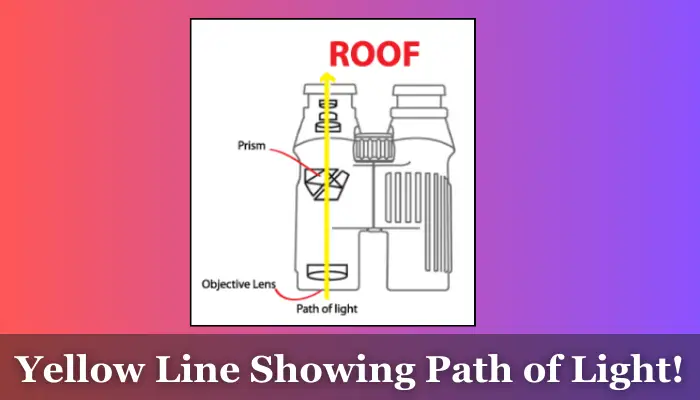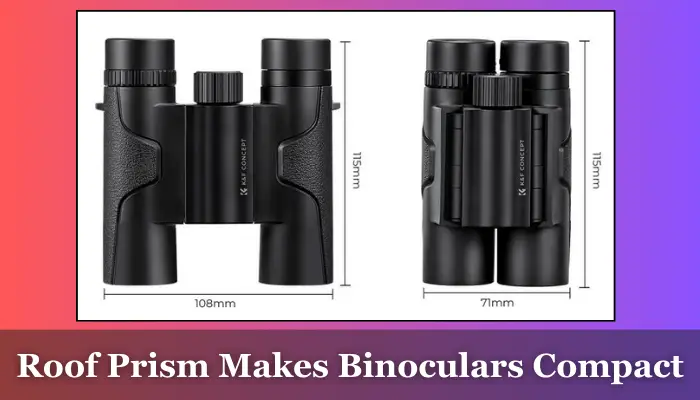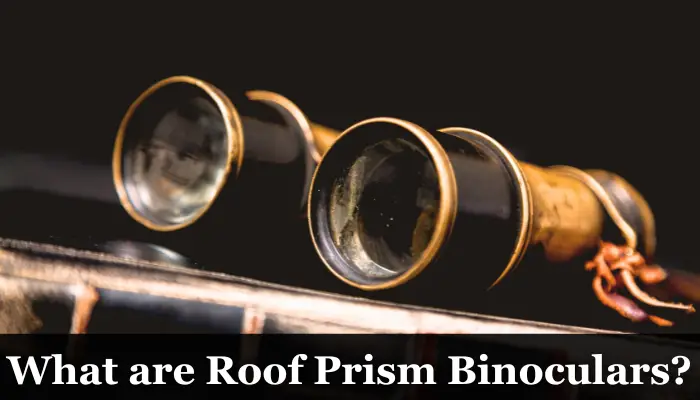This post may contain affiliate links which means I may receive a small commission for purchases made through the links. Learn More
In the past, there was less technology, and the binoculars produced were used to be bulky and less effective as compared to now. Things have changed – and we now use the roof prism binoculars that offer perfect performance yet they are compact.
But the question is: what are roof prism binoculars? Binoculars that use roof prisms are called roof prism binoculars. They are compact, sleek, and streamlined, and offer optimal performance as compared to the Porro prism binoculars.
You should know that binoculars with roof prism are usually more rugged due to better body shape and streamlined design. Here you’re going to learn a lot about the roof prism binos.
Related Article: Who Makes Cabela Binoculars?
Introduction to Roof Prism
As you know, when the objective lens captures the light, it creates an inverted image of the targeted objects. The binoculars consist of prisms that reorient the image and you see a clear, well-oriented image of the target.
As you know there are two types of prisms – but we will be talking about the roof prism. Don’t worry about the other type Porro prism as I will discuss that type in my upcoming guides.
The roof prism is a very useful type as it helps in keeping the binoculars compact and streamlined and makes the light able to travel in a single path. In the roof prism binoculars, the objective lens and eyepiece are usually present in straight lines which ensures that the binoculars will have a simple, sleek straight shape.
Is the roof prism perfect? Well, not really! There are certain issues with both types of prism. However, issues that come with roof prism such as the phase shift are corrected and the users end up seeing perfect visuals of the targeted object.
The good thing is that the roof prism binoculars are always simple to design and shape. The light that enters from the objective lens goes in a single path, the roof prism processes it and then sends it to the eyepiece. This single light path is useful in making the binoculars straightened instead of bulky and ugly.
Working of Roof Prism in Binoculars

If you look at the shape and design of the roof prism binoculars, you would initially think that these binos are simple and the mechanics would also be quite simple. But the reality is the opposite of that! In fact, the working mechanism of the roof prism binos is complex.
First of all, the light enters the binoculars through the objective lens which is common in all types of binoculars. As you know the objective lens sends an inverted image to the prism, so prisms have to reorient the image so that the users can see the target clearly.
But when the light enters into the prism, then many internal reflections and then light exits the other side of the roof prism. During this internal reflection, the phase shift occurs and the impact of this phase shift is different to the light of different wavelengths.
Due to phase shift or delay that happens, it causes an issue or phenomenon when the lights finally recombine to make an image that users are going to see. This issue is called chromatic aberration. Due to this issue, the brightness, and color balance get disturbed.
If the manufacturer does not do anything to reduce chromatic aberration, then the user will get an image with color fringing, and dim brightness. But the binos manufacturers use phase coating on the prism which reduces the chromatic aberration.
Actually, the phase coating present on the roof prism alters the phase of light in a way that compensates for the inherent phase shift. It helps in effectively realigning the colors and improving image quality. The image is reoriented to finally be sent to the eyepiece where users see the zoomed image of the target.
In the whole process, the light travels in one straight line or direction. There is no zigzag movement of deviation of light which makes the roof prism pretty special. Due to the traveling of light in a straight line, manufacturers become able to make the binoculars smaller, and simple in design.
Also Read: Do Binoculars Work at Night?
Advantages of Using Roof Prism in Binoculars
In the section above, I have explained how the roof prism works in the binoculars. But now let’s go down into more details, and explore the potential benefits of using the roof prisms in binoculars instead of any other type.
1- Size and Shape

This is probably one of the most important benefits that manufacturers get by using the roof prisms in the binoculars. As I said earlier, in roof prism binoculars, the light travels in one streamline. The objective lens and the eyepiece come in a straight line to each other.
This streamlined traveling of light helps the manufacturer to make the binoculars H-shape which is more compact and easy in terms of holding and using. Binoculars used to be bulkier in the past when the manufacturers used other porro prisms where the light travels in zig zag manners.
2- Durability
As I said earlier the roof prisms are straight-barrel design, so prisms are usually placed together and there remain no offset characteristics which usually exist in the Porro prism binoculars. When the prisms are clamped together, they always secure or keep their alignment in perfect position even if the binoculars fall out of your hands. This is what makes binoculars more durable as the fall or shocks won’t be able to affect the positioning of the prisms.
3- Optical Performance
When the roof prism is used, phase is always applied to it to combat the issue of chromatic aberration. Due to the phase coating present on the prism, the visual quality of the roof prism binoculars gets better. In the end, you end up seeing brighter, and clear and in-depth visuals of the target that cannot be achieved with any other type of prism.
Note: If you find roof prism binoculars without phase coating, don’t buy it as it would show chromatic aberration, and you would be unable to see the target clearly. Roof prism binos always must have phase coatings to reduce the chromatic aberration which is usually produced due to phase shifts as I explained earlier.
Why Do All the Roof Prism Binoculars Come with Phase Coatings?
I deliberately added this question to ensure that you understand the importance of phase coatings on the roof prism. Let me recall what I have said earlier.
When the light enters the prism, there happens the internal reflection, and phase shifts. Right? The phase shifts that happen differently to light having different wavelengths cause the chromatic aberration which reduces the brightness and image quality.
To reduce or eliminate chromatic aberration, the phase coating is applied on the roof prism to ensure that the user gets perfect visuals. If there is no phase coating on the roof prism, it simply means that there won’t be anything to control the chromatic aberration and you will see dim, and low-quality images.
This is why I said if you are going to buy roof prism binos, make sure that the prism has a phase coating. If there is no phase coating, it means that the manufacturer is cheap and the binoculars are trash. You should not buy that.
To reduce the size of binoculars, a roof prism is used so that light travels in a streamline. However, the roof prism produces chromatin aberration which is controlled by using the phase-corrected coating on the prism. I hope that will be clear now.
Drawbacks of Using Roof Prism in Binoculars
There are many advantages of using the roof prism binoculars as it helps in making the binoculars compact, durable, and easy to use due to better, and user-friendly design and shaping. However, there are a few drawbacks as well which I am going to discuss in the upcoming section.
1- Chromatic Aberration
As I have explained earlier the roof prism when used in the binoculars causes the chromatic aberration which is a real issue. To fight against this chromatic aberration, the manufacturer uses the phase-corrected coating on the prism to compensate for the phase change and ensure that the users get perfect clear visuals.
If the manufacturer does not apply coating on the lenses then you will see chromatic aberration, color fringing, and dimness in the brightness in the image which can be an issue. In fact, some Chinese brands that manufacture cheap and inexpensive binos don’t apply the phase-corrected coating to prisms. Those binos do not offer clarity, so I don’t recommend you buy them.
Takeaway: If you are buying binoculars with a roof prism, then a phase-corrected coat must be applied to the prism so that you can see everything clearly.
2- Pricing and Affordability
Overall, the roof prisms are expensive which makes the binoculars very expensive. This could be an issue for those manufacturers who aim to manufacture inexpensive and affordable options. Although the usage of roof prism enhances the performance, and usability of the binoculars, it also adds up to the pricing.
Conclusion
No doubt that roof prism binoculars offer better results when used for outdoor activities. But they are usually more expensive, which can be an issue for those people who don’t have a handsome budget. However, roof prisms are considered game changers in the binoculars industry. Since the usage of a roof prism, binoculars have become more compact, H-shaped, and easy to use. I hope that this article will add value to your life.

I’m a passionate outdoor activist who has got special love for optics. The school studies in optical mechanics and the travelling experience has made me an expert in optics like binoculars, scopes, and other devices. Stay connected with us for in-depth knowledge!

